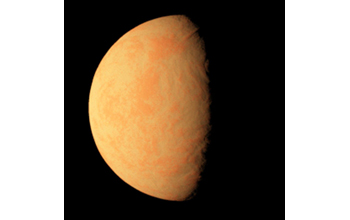Multimedia Gallery
New Super-Earths detected in nearby star's habitable zone (Image 1)
An artist's impression of one of several planet candidates around a star known as Gliese 667C based on the most likely climate models for Earth and Super-Earth mass planets around red-dwarf stars. Pictured here is a completely frozen rock-ice planet with Europa-like cracks and ridges on the surface.
New observations of a star known as Gliese 667C by a team of National Science Foundation (NSF)-supported researchers have revealed a system with at least six planets, including a record-breaking three super-Earths orbiting in the star's "habitable zone." Super-Earths are planets more massive than the Earth, but less massive than planets like Uranus or Neptune, and are within their stars habitable zone--not too hot and not too cold--a thin shell around a star in which water may be present in liquid form if conditions are right. This is the first planetary system found to have a fully packed habitable zone.
The team combined new observations from the Keck Observatory in Hawaii and other telescopes with extensive data collected previously by the High Accuracy Radial velocity Planet Searcher at the European Southern Observatory's 3.6-meter telescope in Chile. [Research supported by NSF grant AST 03-07493.]
To learn more, see the NSF press release Astronomers Detect Three 'Super-Earths' in Nearby Star's Habitable Zone. (Date of Image: June 24, 2013) [Image 1 of 3 related images. See Image 2.]
Credit: René Heller, Leibniz Institute for Astrophysics Potsdam, Germany
Images and other media in the National Science Foundation Multimedia Gallery are available for use in print and electronic material by NSF employees, members of the media, university staff, teachers and the general public. All media in the gallery are intended for personal, educational and nonprofit/non-commercial use only.
Images credited to the National Science Foundation, a federal agency, are in the public domain. The images were created by employees of the United States Government as part of their official duties or prepared by contractors as "works for hire" for NSF. You may freely use NSF-credited images and, at your discretion, credit NSF with a "Courtesy: National Science Foundation" notation.
Additional information about general usage can be found in Conditions.
Also Available:
Download the high-resolution JPG version of the image. (86 KB)
Use your mouse to right-click (Mac users may need to Ctrl-click) the link above and choose the option that will save the file or target to your computer.

